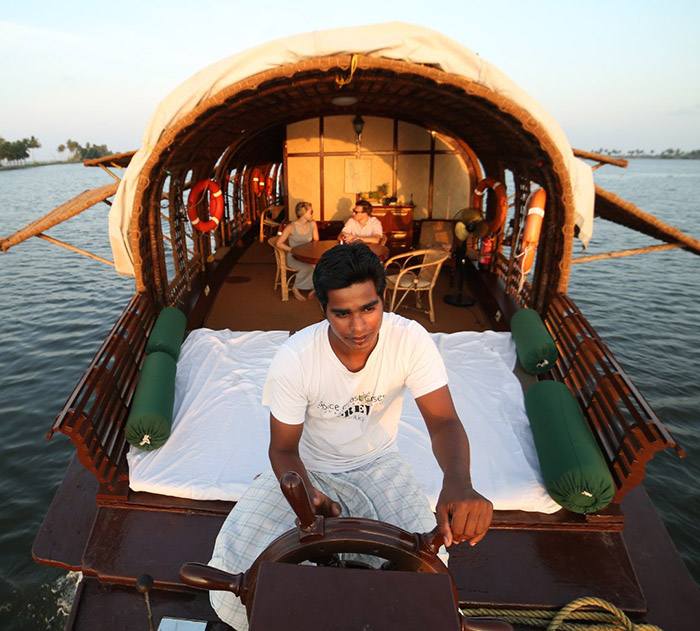
Kettuvallam ferry on the way to Coconut Lagoon; credit CGH Earth Resort
Kerala, Emerald of India
Having traveled to India on business several times, friends and colleagues began to admonish me for not taking the time to explore the country. After all, I was already halfway around the world – what would it cost me to spend a few extra days there?
Kerala is located at the southernmost tip of India. It is a long, narrow state (one of 26 in India) that is bordered on the west by the Arabian Sea and on the east by a mountain range called the Western Ghats. The land is remarkably fertile, fed by rivers and canals that provide a unique environment that the Keralans strive to preserve and maintain. The 350-mile coastline provides both pristine beaches and rocky areas. In the highlands and the hill country, plantations produce tea, coffee, pepper, and spices such as ginger, cardamom, cinnamon, and anise.
When flying over the Ghats to enter Kerala, one sees immense patches of green. As I flew in during the early morning, the mist was still clinging to the treetops. The wisps of grey-white combined with the lush foliage of banana and coconut trees were a breathtaking sight.
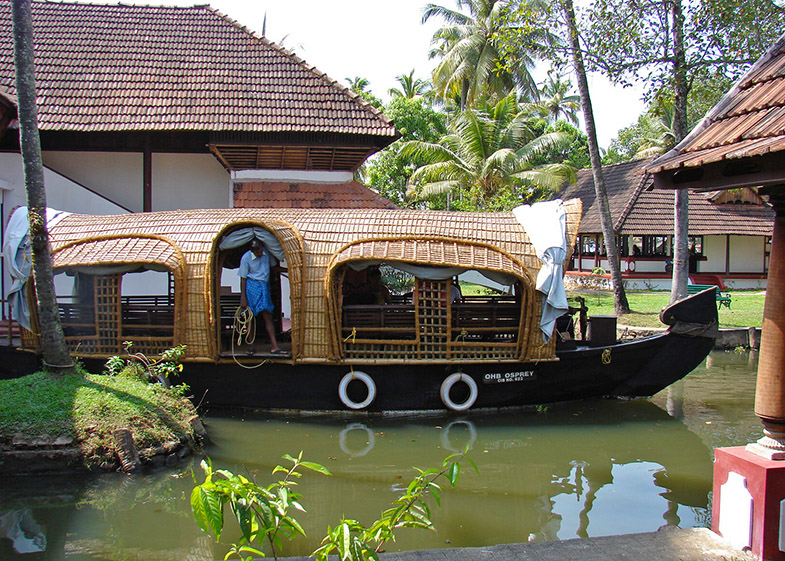
Kettuvallam arrives at CGH Earth Resort; (c) Soul Of America/Monique Wells
I was fortunate enough to book one of the last remaining spots available at Coconut Lagoon, a CGH Earth resort. It is located near the town of Kottayam, in a beautiful and fragile ecosystem known as The Backwaters. It is not accessible by road – one has to go there by ferry.
Depending on your route to the water’s edge, you will either cross Lake Vembanad (25-minute ride) or travel up a large canal (10-minute ride) to arrive at the resort. I took the 10-minute ride, which provided a glimpse into local village life.
Along the route, I could see both banks of the canal. I observed children playing in a schoolyard, boatyards where traditional kettuvallams (sewn canoes) were being constructed, and multiple women and men washing clothes on the rocks on the banks of the canal. Water hyacinth was abundant in the water.
I would later learn that this was because the water’s salinity had been reduced to provide fresh water for crops. When the growing season ends, the saltwater from the sea is allowed to enter the backwater and the water hyacinth dies.
The kettuvallam ferry turned right to enter a smaller canal that flows past the reception area of Coconut Lagoon. Stepping off the boat, I received a wonderful, warm welcome from the staff. A small cluster of brightly colored flowers was thrust into my hand as I was led to a desk, given a list of available activities, and asked to complete a brief form.
A young man then came up to me and presented a fresh coconut with a straw protruding from a small hole at the top. I enjoyed the tender coconut water inside as I watched my luggage being unloaded from the ferry.
Because I arrived well before check-in time, I was asked to wait until my room was available. “Room” does not adequately describe my lodgings, however, for I had booked a “Heritage Mansion” for my stay. These two-story dwellings, the upper floors of which are defined by wooden ribs that resemble the sides of a boat, overlooking Lake Vembanad.
Smaller “Heritage Bungalows” are one-story structures that are located along paths and small canals. For those wanting maximum privacy, Pool Villas are located on a secluded section of the lakefront. Each has a private pool and hammock for your enjoyment. All rooms are air-conditioned, so there is no need to worry about the heat and humidity while sleeping.

Centerpiece of flowers at Tharavadu Restuarant; (c) Soul Of America/Monique Wells
I was shown to a large terrace adjacent to Tharavadu, the main restaurant, and told that someone would show me to my room as soon as it became available. So I sat at a shaded table, continued to sip my tender coconut water, and began to soak in the ambiance.
A beautiful pool lies next to the restaurant and terrace, but I barely noticed it because I could see the staff setting up for lunch in the restaurant. Keralan cuisine had come highly recommended, and I could hardly wait to see what culinary treasures awaited me!
To turn my attention from the dining room, I studied the list of activities that were available. There are yoga sessions, kalarippayattu practice (a form of martial arts, to be observed only), cooking demonstrations, a village walk, butterfly/dragonfly watching, and a sunset cruise on the lake to be enjoyed at no charge.
Paid activities include bird watching at the neighboring bird sanctuary, various rafting and boating experiences (including water skiing), and private cooking classes.
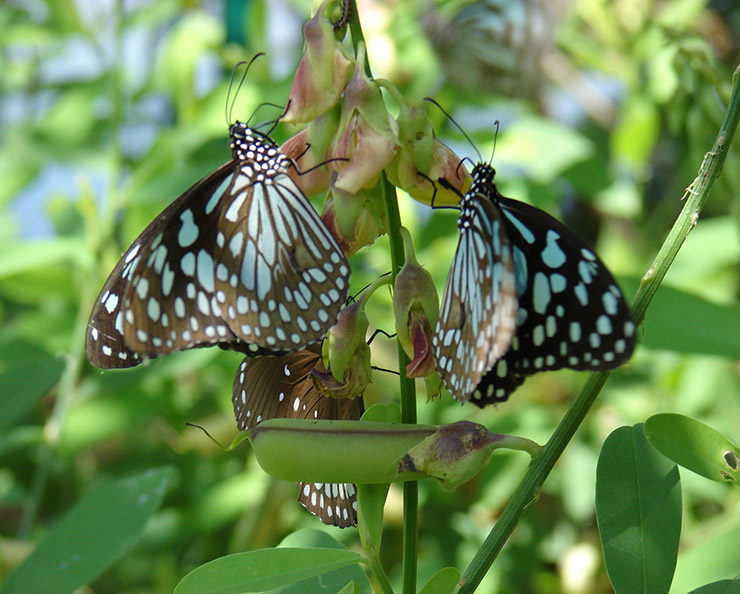
Glassy Blue Tigers butterfly on resort grounds; Soul Of America/Monique Wells
For three days, I indulged myself in utter relaxation. I toured the property with the assistant general manager, Dinu, who spoke not only about Coconut Lagoon but also about the life and customs of the Kerala people.
I visited both butterfly gardens at the resort and made my first attempts at nature photography. One of the resort’s naturalists helped me to identify and photograph the more evasive butterflies, and even showed me a snake that he had rescued from the clutches of a hungry predator.
I attended yoga classes every morning and evening and took advantage of the Ayurveda Center (Ayurveda is a traditional method of healing in India) to procure holistic medication for a pesky cough. And I ate like a queen!
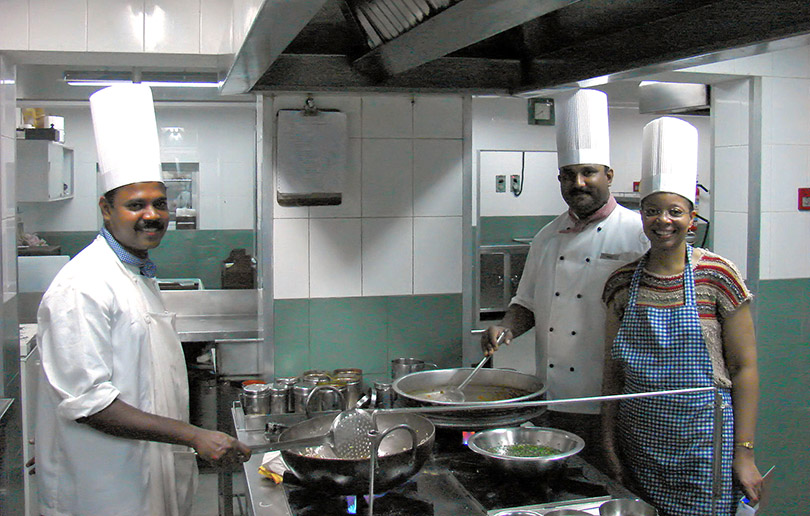
Coconut Lagoon CGH Earth Resort cooks and Monique Wells; credit Soul Of America/Monique Wells
I had arranged for a private cooking demonstration prior to my arrival and was not at all disappointed. I was privileged to receive a complete tour of the Tharavadu kitchen prior to observing the chefs create all the dishes to be served for dinner that evening.
I also received a lesson in identifying local produce. I learned that my tutor, Chef Majo, was in charge of Fort Cochin, the seafood specialty restaurant on the opposite side of the resort.
The free cooking demonstrations were also interesting, with two simple dishes being prepared during each session in the dining room at Tharavadu. South Indian cuisine is largely vegetarian and this was reflected in the recipes that were prepared. But poultry and meat lovers need not despair. The restaurant provides all types of food and drink.
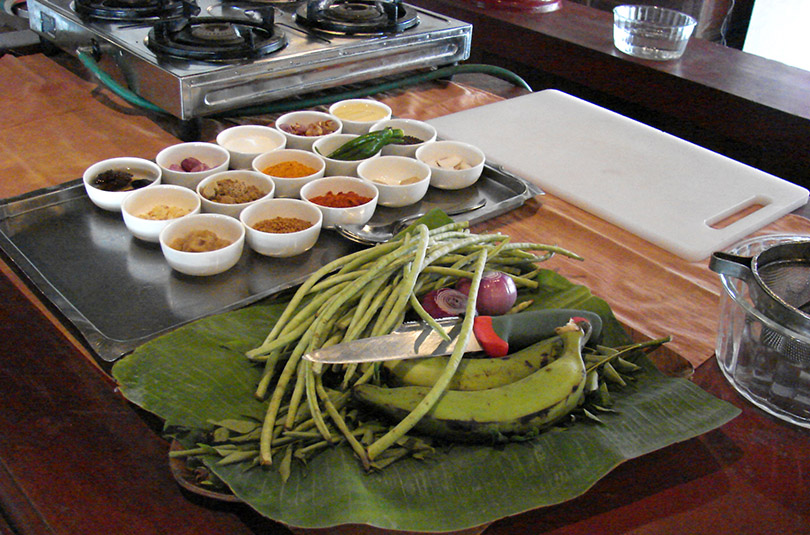
Mezhukkupuratty ingredients at Tharavadu Restuarant; (c) Soul Of America/Monique Wells
The service at Coconut Lagoon was impeccable. Everyone always greeted me with a smile, and by the end of my first day, everyone knew my room number and my dining preferences. When I expressed interest in the spirits being sold at the bar, the bartender allowed me to inspect every bottle in the cabinet.
At check-out, when I expressed concern that my departing flight might have been delayed or canceled, Dinu immediately phoned my airline to inquire about it on my behalf.
When you visit Coconut Lagoon, CGH personnel greet you at the airport, provide a private transfer to the ferry, and shuttle you to the resort. The company has a “no-tipping” policy – if you wish to show your appreciation for the service provided, you are asked to add a discretionary sum to your bill or place cash in a specially identified box. This money is divided equally among the entire staff.
For a complete change of scene and a chance to get away from it all, Coconut Lagoon is a great option!
CGH Earth Experiences
Casino Building, Willingdon Island
Cochin, Kerala, India
https://www.cghearth.com
Kerala Travel Tips
Essential tips for Traveling While Black, traveling as a woman, and traveling solo in this region of India.
